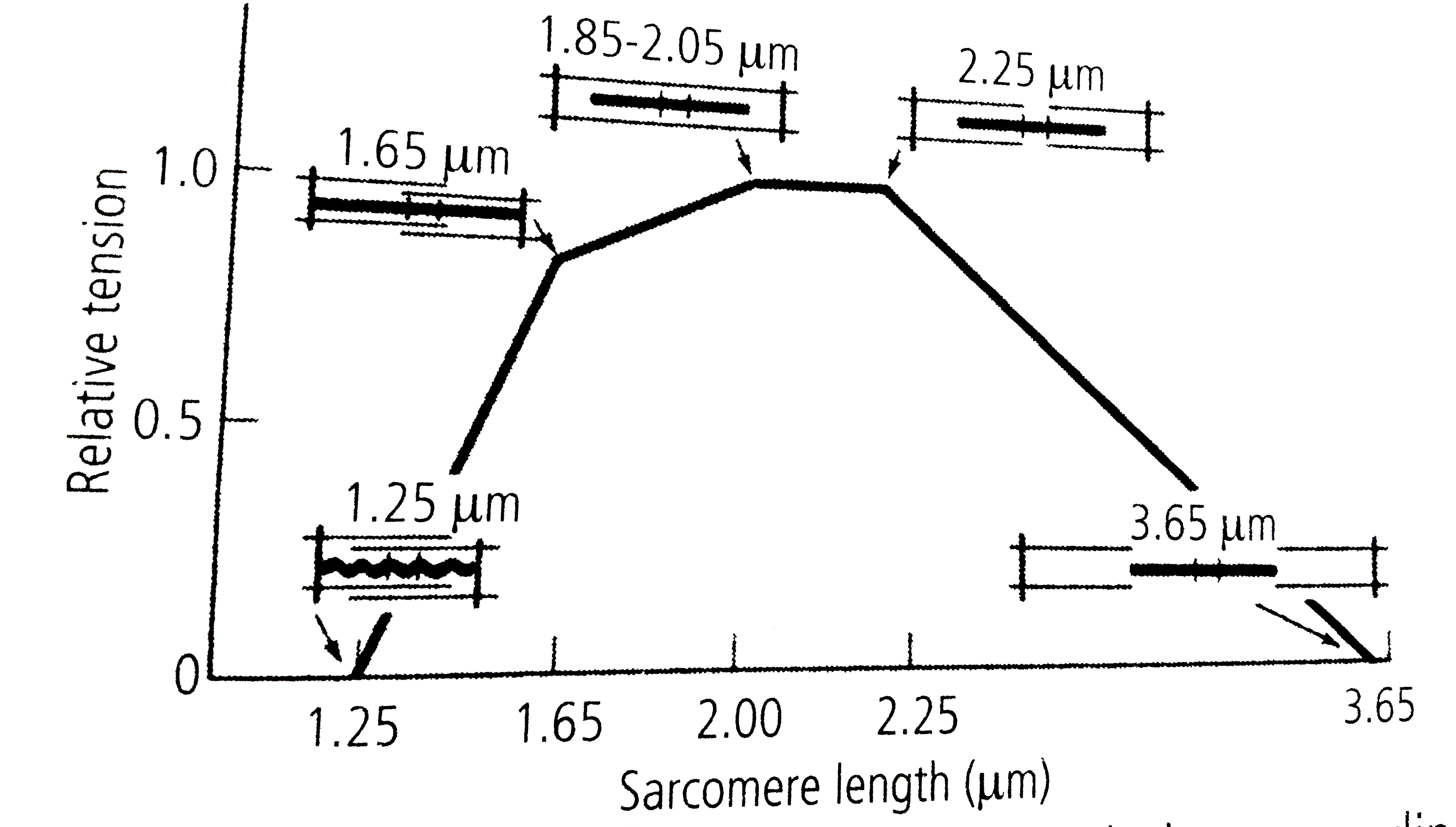Cross bridges pull the actin chain as the myosin heads return to their unenergized conformation.
true
Topper's Solved these Questions
- LOCOMOTIONA ND MOVEMENT BOOK - ICSECHAPTER - LOCOMOTIONA ND MOVEMENT EXERCISE - TEST YOUR PROGRESS ( VERY SHORT ANSWER TYPE QUESTIONS )
73 Videos
- LOCOMOTIONA ND MOVEMENT BOOK - ICSECHAPTER - LOCOMOTIONA ND MOVEMENT EXERCISE - TEST YOUR PROGRESS ( SHORT/LONG ANSWER TYPE QUESTIONS )
31 Videos
- LOCOMOTIONA ND MOVEMENT BOOK - ICSECHAPTER - LOCOMOTIONA ND MOVEMENT EXERCISE - TEST YOUR PROGRESS ( OBJECTIVE TYPE QUESTIONS ) (Fill in the blanks with appropriate words.)
20 Videos
- LOCOMOTION AND MOVEMENTBOOK - ICSECHAPTER - LOCOMOTION AND MOVEMENTEXERCISE - LONG ANSWER TYPE QUESTIONS
14 Videos
- MINERAL NUTRITION BOOK - ICSECHAPTER - MINERAL NUTRITION EXERCISE - NCERT EXERCISE WITH ANSWER (DIFFERNTIATE BETWEEN )
9 Videos
Similar Questions
Knowledge Check
The given graph shows length-tension curve for a typical vertebrate sarcomere.

By analysing the graph, what can you deduce regarding the muscle contraction?
(i) Neither the myosin filaments nor the actin thin filaments change in length when a sarcomere shortens or is stretched. Instead, it is the extent of ocerlap between actin and myosin filaments that changes.
(ii) The total tension produced by a sarcomere is proportional to the total number of cross-bridges that can interact with actin filaments, and this number in turn is proportional to the amount of of overlap between thick and thin filaments.
(iii) The tension produced by the muscle is maximal when the overlap between thick and thin filamentss allows the largest number of myosin cross-bridges to bind to actin.
(iv) Tension drops off with increased lenght, because the thick and thin filaments overlap less and fewer cross-bridges can bind.
Tension drops off with decreased length, because thin filaments at the two ends of the secromere begin to collide with each other, preventing further shortening.A(i) OnlyB(i),(iii) and (iv)C(i),(iii),(iv) and (v)D(i),(ii),(iii),(iv) and (v)Which of the following statements about the molecular arrangement of actin and mysin In myofibre is/are incorrect ?
(i) Each actin (thin filament) is made of 2F (filamentous) actins.
(ii) F-actin is the polymer of G (globular) actin.
(iii) 2F0actins are twisted into a helix.
(iv) Two strands of tropomyosin (protein) lie in the grooves of F-actin.
(v) Troponin molecules (complex proteins) are distributed at regular intervals on the tropomyosin.
(vi) Troponin forms the head of the myosin molecule.
(vii) The myosin is a polymerised protein.A(i), (iii) and (vii)B(ii), (iv) and (v)COnly (vi)DOnly (iii)
Assertion : Ca2+ plays important role in the musclc contraction.
Reason : Ca2+ Combines with troponin chain, displacing tropomyosin allowing the myosin head part to combine with actin to from actomyosin complex .
(a) If both Assertion and Reason are true and the Reason is the correct explanation of the Assertion.
(b (b) If both Assertion and Reason are true, but the Reason is not the correct explanation of the Assertion.
(c) If Assertion is true, but Reason is false .
(d) If both Assertion and Reason are false.
View SolutionThe steps involved in the mechanism of muscle contraction are given below.
Arrange the steps in proper sequential order and select the correct option.
I. Release of calcium ions in the sarcoplasm.
II. Signal sent by the CNS via a motor neuron.
III. Binding of calcium with a subunit of troponin on actin filaments.
IV. Generation of the action potential in the sarcolemma.
V. Binding of myosin head to the exposed active sites on actin to form a cross-bridge.
VI. Inward pulling of ‘Z’ line attached to actin causing shortening of the sarcomere.
VII. Pulling of the attached actin filaments towards the centre of 'A' band.
VIII. Release of neurotransmitter acetylcholine and generation of the action potential in the sarcolemma.
View SolutionName the ion responsible for masking active sites for myosin for cross-bridge activity during muscle contraction
View SolutionAn aluminium wire of cross-sectional area (10−6)m2 is joined to a steel wire of the same cross-sectional area. This compound wire is stretched on a sonometer pulled by a weight of 10kg. The total length of the compound wire between the bridges is 1.5m of which the aluminium wire is 0.6m and the rest is steel wire. Transverse vibrations are setup in the wire by using an external source of variable frequency. Find the lowest frequency of excitation for which the standing waves are formed such that the joint in the wire is a node. What is the total number of nodes at this frequency? The density of aluminium is 2.6×(103)kg/m3 and that of steel is 1.04×104kg/m2(g=10m/s2)
View SolutionThe myosin myofilament can be cleaved into a head and a tail piece. All of the following are accurate in describing the position of myosin in a sacromere except
(i) A-band is the length of a myosin myoilaments
(ii) A-band contains thin and thick myofilaments
(iii) A-band does not include actin-binding sites
View SolutionThe correct sequence of events during relaxation of muscle is :−
(i) Inactivation of the actin
(ii) Ca++ returend to SR
(iii) Cross bridges are boken
View Solution
